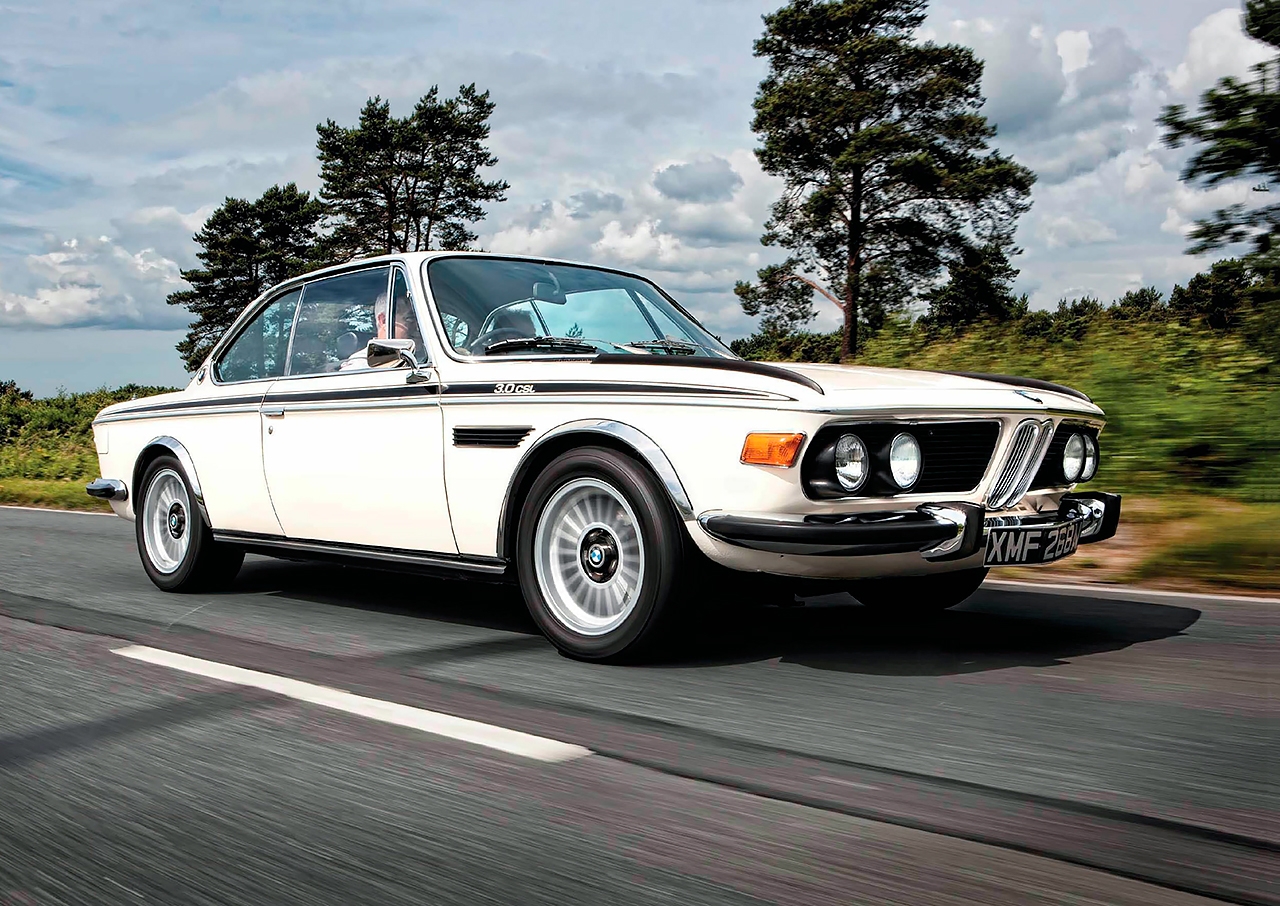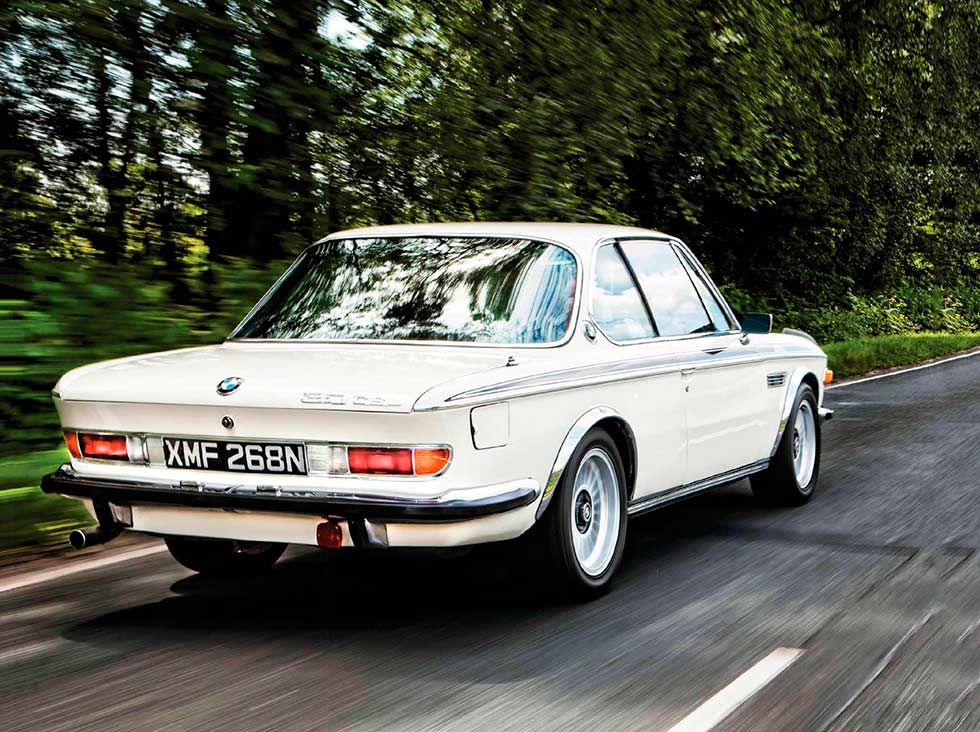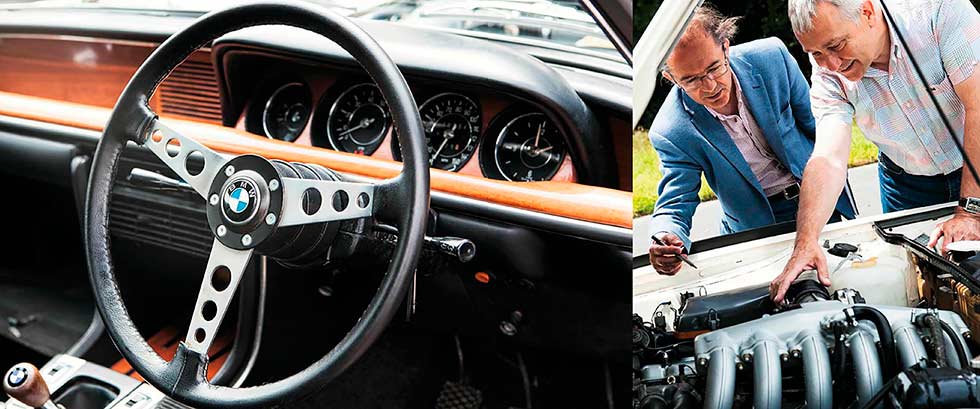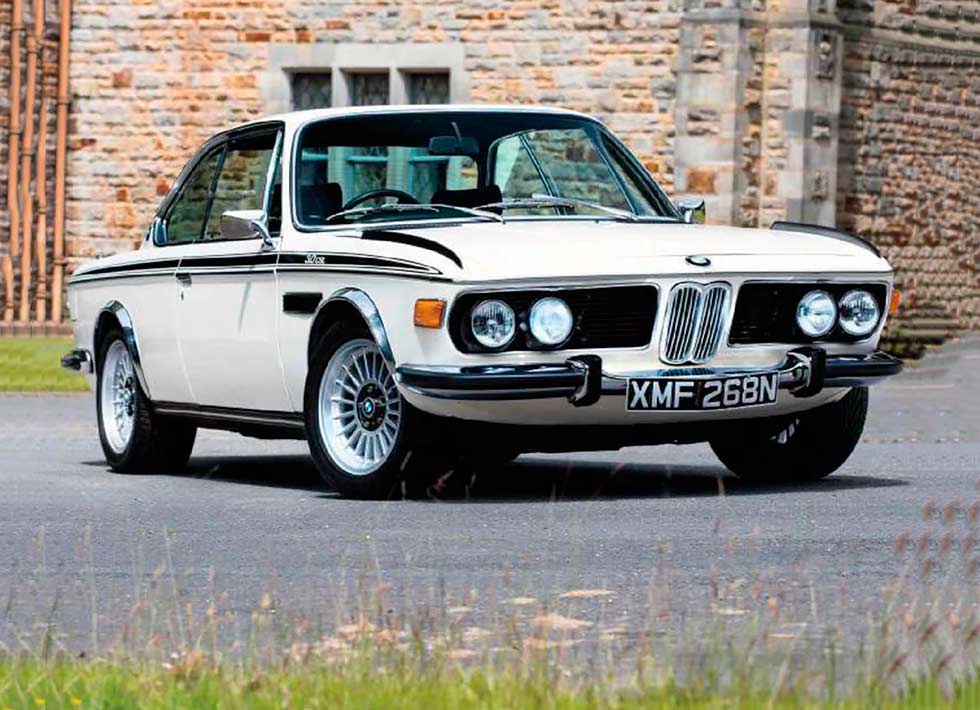
The List. Watching Seventies racing fired reader and Porsche racer Stuart Hellon’s passion for the BMW 3.0 CSL E9. We make his dream of driving the road car come true. I’ve wanted to drive a BMW 3.0 CSL since Silverstone ’1976. Reader Stuart Hellon realises his dream of driving a BMW 3.0 CSL. A 16th birthday trip to Silverstone introduced Stuart Hellon to the mighty, all-conquering CSLs but despite owning some special BMWs since, he’s never got behind the wheel of his lifelong hero car. Until now. Words Russ Smith. Photography Neil Fraser.
The List
BMW 3.0 CSL E9 ’I drove Dad’s E3 aged 18 and it was only a short step to the race CSLs I saw rule for years’.
Plymouth Roadrunner Superbird ‘Looks loopy, designed for competition, with grunty V8 and ‘that’ nose and rear wing’.
Lancia Stratos ‘Nothing else looks like it – a purpose-built rally car for my heroes. Alitalia colours rule!’
Triumph Stag ‘Burbling V8, show car looks, but unfortunately Seventies BL quality. Flawed genius’.
Maserati Bora ‘Citroën hydraulic weirdness, Italian brawn and style; a milemunching and classy GT.
Keen to establish his sporting BMW credentials, Stuart Hellon arrives at our rendezvous to drive a car from his wishlist brandishing a copy of the January 2014 issue of Classic Cars. ‘Look, you drove my old M3 Evo II for an Ads on Test story when it was for sale at KGF Classics,’ he says. ‘I bought it as a trackday car for £8500, but it became too valuable to leave unattended anywhere and not using it was costing me a lot. So I sold it and bought a couple of cheaper classics I could actually enjoy driving.’

‘I can imagine myself driving it at Spa.’ Stuart’s memories of Seventies CSL racers come flooding back.
Using cars to the full is something that’s dear to Stuart’s heart. He has raced Porsche 924s and 944s in the past and today he’s driven the 160-odd miles down from deepest Lincolnshire to Munich Legends’ East Sussex premises in his bright blue 1999 Fiat Coupé Turbo, so there are no qualms about letting him loose in Dan Norris’s rare and lovely UK market BMW 3.0 CSL E9. This is a car that has always been right at the top of his wish list, but has also always remained tantalisingly out of reach. Time to put that right – at least for one day.
Stuart was smitten by these cars at an impressionable age. ‘My brother-in-law took me to the British round of the 1976 Championship of Makes at Silverstone as a 16th birthday treat. The BMWs won – that was my first memory of CSLs and I was hooked. Then my dad bought a BMW E3 2500 saloon a year or so later. I’d just passed my test and he let me drive it.
‘He knew he could trust me because I used to practise in my brother’s Escort Mexico MkI on a patch of land behind our house way before I could officially drive. He was happy for me to keep it up and running while he was away serving in the RAF. Anyway, that E3 experience really got me going on BMWs.’
There seems little need to delay proceedings any longer. Finally, almost exactly 40 years after watching Tom Walkinshaw and John Fitzpatrick win that six-hour race at Silverstone, it’s time for Stuart to meet his motoring hero. Initial impressions are good, ‘It’s absolutely stunning, a real work of art – like looking at a painting,’ he says. It does appear to have shrunk though. ‘This was actually considered to be quite a large car in its day, but now it looks about the size of a modern 3 Series.’
Racer Stuart slips expertly into the Scheel driver’s bucket seat. ‘It’s more tilted back than it is in a modern car, but it’s definitely a race seat. It really adds to the sense of occasion, as if you’re waiting for the lights to change at the start of a race.’ He’s not kidding about the tilt – I slump into the passenger seat with a great deal less finesse.
It feels very laid-back and high under the knees, as though it’s been flung backwards by a hard burst of acceleration – disconcerting, because we haven’t even turned the key yet. We discover later that the seats are adjustable for rake and height at both front and rear – if you have a handy spanner to reposition them on their frames, that is. Ours have been set to suit owner Dan, who is apparently rather taller than either of us.
Stuart returns to the plot. ‘It feels friendly – everything is to hand and in front of the driver. And you can see out of it so well – the waistline is low and the glass area is large. I’m also struck by how delicate things are compared to modern cars – the stalks, controls, even the steering wheel.’ He grins, ‘And I like the way the heater control markings are in German, despite this being a UK car.’

Russ and Stuart discuss the free-revving joys of the CSL’s 200bhp six-cylinder engine. Stuart is forgiving of the CSL’s plasticky wood trim. ‘It’s all part of the charm’
With a twist of the remarkably modern-looking dimpled key, Stuart’s grin broadens and the pre-warmed engine bursts into life. ‘It’s got that vibe and a busy, high idle speed you wouldn’t get in a modern performance car. But you can also hear echoes of the E46 M3’s S54 six-cylinder engine in there. I had one of those and you can sense the lineage between the two just from the sound of it.’
We pull away and head for some promisingly quiet roads Dan has told us about. ‘There’s a very mechanical feel to the gearchange – it’s nice and tight considering how old it is and has the same sort of metal-on-metal snick that Mazda deliberately engineered into the MX-5’s gearbox to make it feel sporty.’
Then, as we slow for a junction a few miles down the road, we get a taste of classic car reality – the engine stumbles and dies, then refuses to restart. The fact that the CSL is so Leicht comes in handy as we push it to the side of the road.
Poking around under the bonnet reveals nothing obviously amiss, but the engine fires again once it’s cooled down a bit. We repeat this process several times until – finding ourselves in a handy pub car park – we decide to go no further until we’ve dug deeper into the problem. Something in the engine bay is being affected by heat build-up, with the coil and its low-tension circuit connections appearing the likely culprits. We’re equipped with nothing more than a tiny Swiss Army knife, so a quick call to Munich Legends has Dan and a mechanic on the scene in minutes. Dan looks nonplussed back at the workshop as he inspects the BMW. ‘I use it regularly and drive all over the place in it, including the commute into work,’ he says. ‘It’s never done anything like this before, although it has been sitting unused for the last fortnight because of the weather.’
Dan returns the keys to us after 20 minutes spent checking and cleaning connections, along with instructions to keep the manually operated electric fan on at all times. ‘It’ll be fine now,’ he assures us. And he’s right – the car performs faultlessly for the rest of the day. Stuart is palpably relieved that his dream drive will run its course after all and his broad smile soon returns. Worries lifted, he can now get to grips with the CSL. ‘There’s a weight and feel to all the controls that you just don’t get from anything else,’ he says. ‘It’s so involving.
You’d expect an early Seventies car this powerful to have a heavy clutch, but it’s actually quite light and bites cleanly. The steering is lighter than I expected too, even at low speeds. If anything, maybe it’s a little too light at speed – it’s not off-putting exactly, just different. I’m still getting used to it and making all the necessary mental adjustments. It will probably feel like second nature by the time that we’ve finished.
‘Certainly, I already love the way I can feel everything happening. And that’s surely a major factor in why those who get the bug love driving older cars. Modern cars have all the soul engineered out of them; necessarily so, I suppose, in the name of safety and technology. They may be quicker and ultimately more capable, but they don’t provide anywhere near the same sort of buzz at the same sort of speeds that the CSL does.

Stuart is enthralled by the CSL’s styling. ‘It must have looked like something from another world in 1974’
‘It has a bit of racecar about it even at roads speeds; I can almost imagine myself at Spa, running down the hill towards Eau Rouge. Actually that would be awesome; I’ve raced there in Porsches and would love to try it in a CSL. Or perhaps drive a race version for six hours at Silverstone…’
It appears we’ve drifted back to Stuart’s rebooted nostalgia for that grand day out in 1976, aided by a series of sweeping downhill bends through Ashdown Forest.
There’s certainly a hint of Spa to them, though on a rather smaller, tighter scale, but is the CSL at home here? Stuart’s certainly impressed by the ride, ‘It doesn’t take your spine out even on these bumpy roads. But it’s more of a grand tourer than a back-road car, and all the better for it.’
Back on the undulating and tree-canopied A22 heading for Lewes, Stuart expands the point. ‘200bhp isn’t considered a lot today but the CSL really benefits from its lightness. It’s still a deceptively quick car – I always seem to be going more quickly than I think I am when I look at the speedometer. I reckon I’d have to be careful about that, but it’s be a great car to take to the Le Mans Classic, or maybe even keep going all the way down to the south of France.
‘That would certainly be no chore. It has such flexible power delivery and pulls well from as low as 1100-1200rpm – it’s really impressive for a 42-year-old performance car. And those front wing splitters are almost like aiming points for apexes.’
Those black plastic appendages may not be standard but were such a memorable feature of the racing CSLs that they have always been a popular add-on for roadgoing models. Dan Norris certainly isn’t about to apologise for them, telling us later, ‘You have to have them, don’t you? They’re part of the whole mystique that surrounds 3.0 CSLs, and they look kind of naked without them. I’ve also fitted 16-inch alloy wheels in place of the original 14-inchers. But that’s okay because they were an option when the CSL was new and really transform the way the car feels in the corners – it’s a lot tighter and more responsive without those tall tyre sidewalls to compress.’
That single, straightforward tweak explains Stuart’s following observation. ‘It’s surprising how tight the car feels given how old it is. I can understand why Dan uses it so regularly. It’s really easy and engaging to drive. In some ways it’s so good and so efficient at what it does that it’s not really like driving an old car at all. Apart from the glorious sound, that is – that’s something else that seems to have been deliberately engineered and legislated out of modern cars, and I think we’re all the worse off for it.’
Parking up at Ashdown Park Hotel allows a little time for reflection. The seating position for instance may have seemed peculiar earlier on, but we’ve both felt comfortable and well supported all day.
Stuart eyes the car’s lines and says, ‘You know, it’s a really nice car to look at when you step back from it. But I think you have to put it into context to truly appreciate it. The CSL existed at the same time as cars such as the Ford Cortina MkIII, Granada MkI and Morris Marina – it must have looked like something from another world. I think it still does – it’s an old masterpiece, even if the cabin is trimmed with all that strange German wood that looks like plastic. That’s all part of the charm.
‘And of course this was where the M Power tradition began. That’s my feeling – that this car was the start of something important and special. It’s been a real privilege to drive it – not many people ever get the chance – and I’ve loved the experience. This might sound a bit odd but driving one of these cars is a bit like seeing a favourite grandad. He might be old but you always have fun.’
There’s a brief lull in what has been a day of constant car chat as we back head down the A275 towards Munich Legends, then Stuart finally plucks up the courage to ask, ‘Do we really have to drop it back now, or can we do another loop?’ No words are needed, just matching naughty boy grins and a raised eyebrow in confirmation from me. We sail past Munich Legends’ entrance as though it isn’t there. The BMW 3.0 CSL really is that sort of a car – once you start driving it, you don’t want to stop.
And anyway, Stuart has had to wait 40 years to get behind the wheel of his dream BMW, so what’s another four miles of twisting country lanes between friends?
THE IMPORTANT MODELS
BMW 2800 CS E9 The BMW six-cylinder coupé legend starts in 1968, with a 5in-longer version of the fourcylinder 2000 CS. The 2.8-litre engine gives 170bhp. At £4997 – 60 per cent more than an E-type 2+2 – it’s BMW’s most expensive car.
BMW 3.0 CS E9 Replacing the 2800 CS in 1971, 3mm larger bores bring capacity up to 2985cc; power now 180bhp. Torque gets an even bigger hike, up 15lb ft. New rear discs brakes, suspension geometry improvements and wider tyres.
BMW 3.0 CSI E9 1972’s CSi has Bosch D-Jetronic fuel injection, replacing twin Zenith carburettors. Peak power now 200bhp – at 500rpm lower down the rev range. Top speed rises from 130mph to 135mph, while the 0-100mph sprint is slashed by two seconds.
BMW 3.0 CSL E9 The ultimate CS – also a 1972 arrival – raises capacity to 3003cc. Motorsport homogolation brings 14in alloys and aluminium door, bonnet and boot panels, plus thinner-gauge steel panels and lighter seats. Removing soundproofing results in a 65kg weight saving.
BMW 3.5 CSL E9 The 420bhp Group 5 racer wins three races and finishes a close second behind Martini Porsche in the 1976 World Sportscar Championship using a 3496cc version of the six-cylinder engine. The CSL pictured above inspired Hellon’s lifelong love of the car.
TECHNICAL DATA 1974 BMW 3.0 CSL E9
Engine 3003cc straight-six, SOHC, Bosch D-Jetronic fuel injection
Power and torque 200bhp @ 5500rpm; 200lb ft @ 4300rpm
Transmission Four-speed manual, rear-wheel drive
Steering Ball and nut, power-assisted
Suspension Front: MacPherson struts, coil springs, lower links and antiroll bar. Rear: independent by semi-trailing arms, coil springs, telescopic dampers and anti-roll bar
Brakes 10.7in ventilated discs front and rear, servo-assisted
Weight 1312kg (2887lb)
Performance Top speed: 134mph; 0-60mph: 7.3sec
Fuel consumption 18mpg
Cost new £7399
Values now £37,500-£100,000
‘There’s feel that you just don’t get from anything else – it’s so involving’
‘It’s a real work of art – like looking at a painting. That’s how it feels to me’
{module BMW E9}
LATEST PHOTOS FROM BMW E9 CLUB
{module E9 ALBUM}





